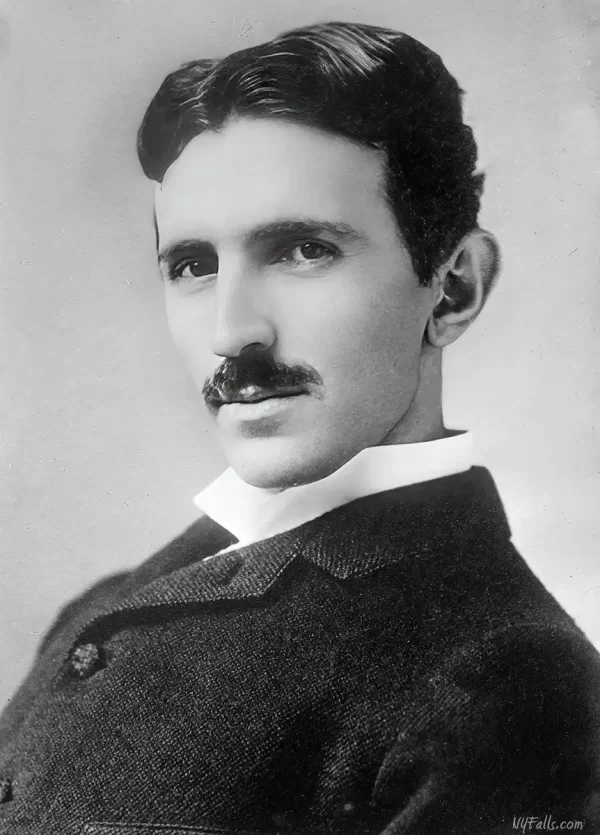Niagara Falls FAQ: Power Generation
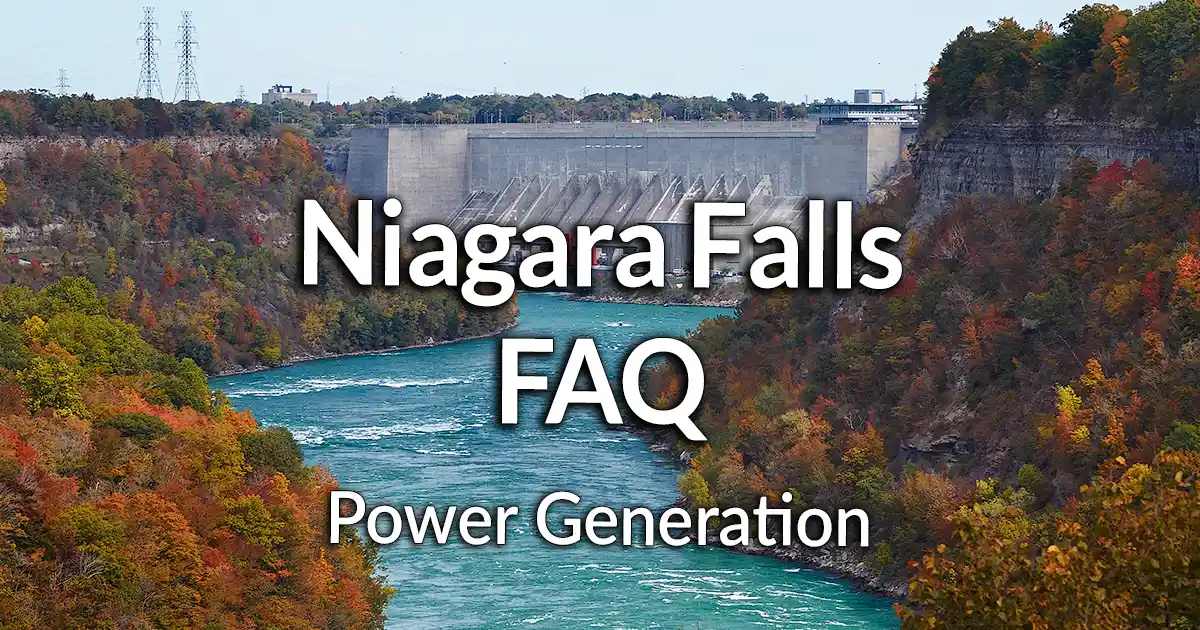
- Which side should I visit (US or Canada)?
- Do I need a passport to cross the border?
- What do children need to cross the border?
- Can I bring my dog/cat across the border?
- Can I walk across the Rainbow Bridge?
- What are the wait times for border crossing?
- Is my US driver’s license valid in Canada and vice versa?
- Is my automobile insurance valid while in Canada?
- Where can I exchange my currency?
- How tall is Niagara Falls?
- Are Niagara Falls the tallest in the world?
- What shape are the Falls?
- Where does all the water come from?
- How fast does water fall down Niagara Falls?
- Why is the water that shade of blue/green?
- What is that foam below the falls?
- Why do they call it Luna Island?
- What are the rock layers that make up Niagara Falls?
- How loud is Niagara Falls?
- Where did the name ‘Niagara’ come from?
- How old is Niagara Falls?
- Have the Falls ever stopped flowing?
- Has Niagara Falls the Falls ever frozen over?
- Has a boat ever gone over the falls?
- How many people have gone over the falls?
- Why isn’t the “Cave of the Winds” an actual cave?
- How far have the falls moved over time?
- How did they build the first bridge over the Niagara Gorge?
- How much of the water is being diverted for power generation?
- When and where was electricity first generated at Niagara Falls?
- Was electricity discovered at Niagara Falls?
- How many power plants are there at Niagara Falls?
- Which power station is the biggest?
- How do the power plants turn water into electricity?
- How much power is generated by Niagara Falls?
- How has power generation changed the Falls?
- What are those structures upstream from the falls?
- What does the International Control Dam do?
- When is the best time to visit Niagara Falls?
- Where is the nearest airport?
- How long should I plan to stay at Niagara Falls?
- Can I bring my dog to Niagara Falls?
- Do I have to pay to see Niagara Falls?
- Where can I park my car when visiting Niagara Falls?
- How many people visit the Falls each year?
- Which Fallsview hotel has the best view of the Falls?
- When do they light up the falls?
- Can I request colors for Niagara Falls lights?
- When are the fireworks?
- What spots offer the best view for watching the fireworks?
- How long does the park stay open?
- Are the Falls turned off at night?
- What is the legal age to drink alcohol and visit a casino?
- What Casinos are near Niagara Falls?
- What tours of Niagara Falls are available?
- Where can one play Golf at Niagara Falls?
- Where is the best view of Niagara Falls?
- What is the closest viewing area at Niagara Falls?
- Is Niagara Falls accessible to the disabled?
- How long is the Niagara River?
- What is the elevation difference between Lakes Erie & Ontario?
- When the Niagara River splits around Grand Island, does it become two rivers?
- Where is the Niagara River deepest?
- How did the Niagara Whirlpool form?
- In what direction does the Niagara Whirlpool flow?
- How deep is the water at the Niagara Whirlpool?
- What classes of rapids are in the Niagara River?
- What is Devil’s Hole?
- Where are the Niagara River Gorge walls the tallest?
Niagara Falls Visitors Guide
This Comprehensive Niagara Falls Historic Timeline is a part of our Niagara Falls Guide, a comprehensive look at The Falls, top attractions, and other awesome parks in the region, with a focus on photography and nature.
How much of the water is being diverted for power generation?
The simple answer is: most of it.
At any given moment the water diverted upstream from the falls, to run the various power plants, is anywhere from 60 to 75%. That’s an average of 1,200,000 gallons (4,542,500 liters) of water per second with only 600,000 gal/sec (2,271,250 liters/sec) left to run over the Horseshoe Falls and a mere 150,000 gal/sec (567,811 liters/sec) for the American Falls. Although it may seem as though the Falls are being deprived of their natural flow, the water that remains to cover the falls is still an impressive sight. Many waterfall enthusiasts agree that reduced flow makes for waterfalls with more “character.”
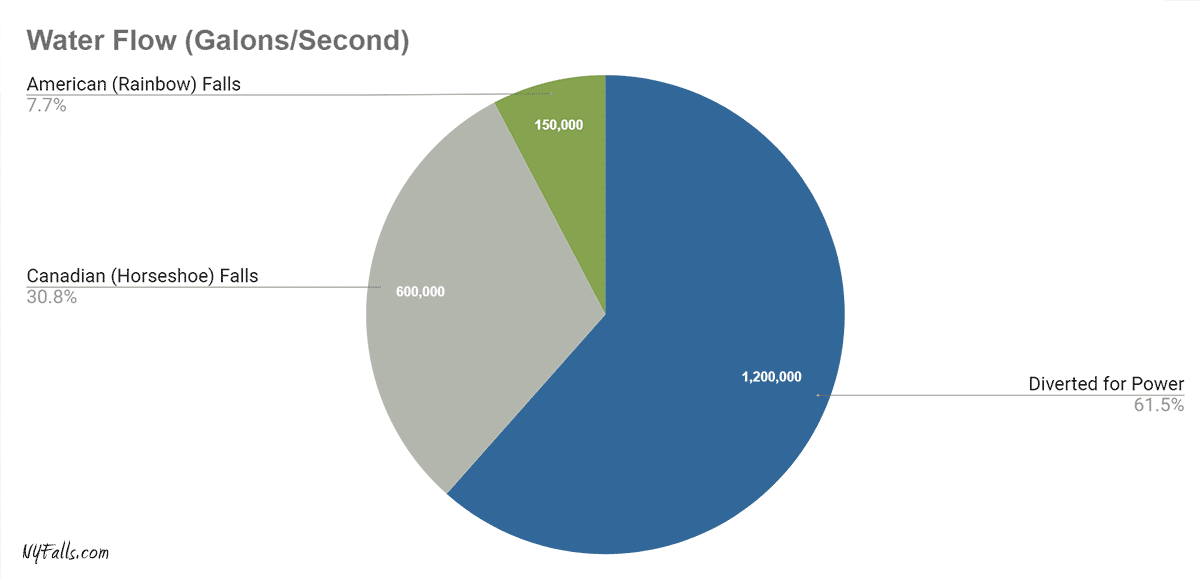
When and where was electricity first generated at Niagara Falls?
Although mills have been using diverted water from the Falls as a source of hydraulic power since 1759, it wasn’t until 1882 that the Falls were used to generate electricity.
The Niagara Falls Hydraulic Power & Manufacturing Company, which constructed a canal for hydraulic power generation nearly 20 year prior, began operating a small electrical plant in Niagara Falls, New York in 1882. The plant, which generated direct current (DC), could only distribute current a distance of 2 miles. Despite this limitation, it was a big hit for both its utility and as a tourist attraction. It was this small plant that demonstrated the potential for hydro-electric power from Niagara Falls.
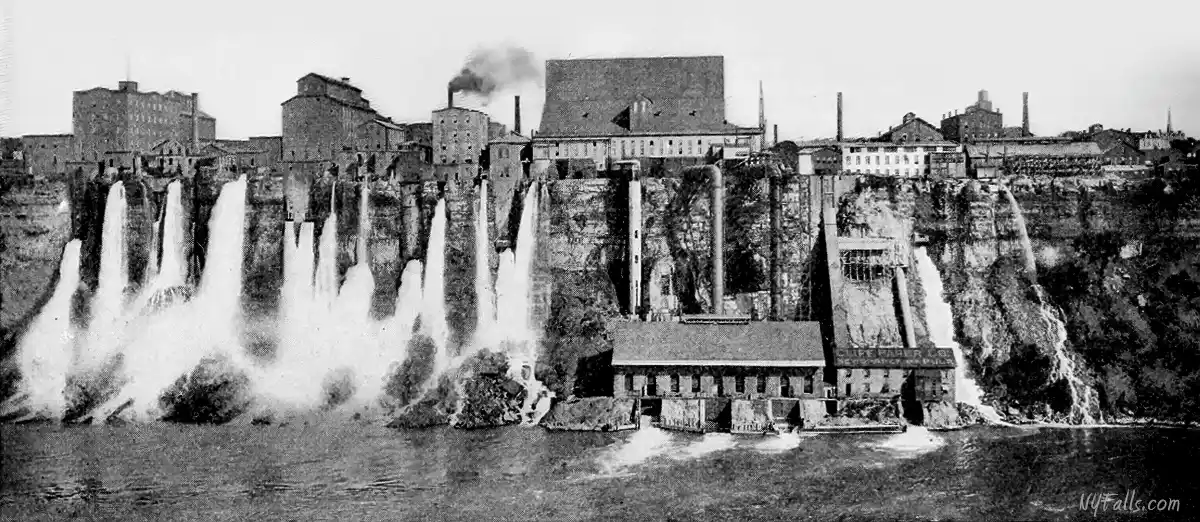
Was electricity discovered at Niagara Falls?
Electricity was not discovered at Niagara Falls, but the Falls did play an important role in how we use electricity today.
In the mid 1800s, renowned engineering genius Nikola Tesla developed a system of alternating current (AC) that would allow for generated electricity to be distributed over distances much further than direct current (DC). When the electric-generating industry was in its infancy one of the major hurdles to its success was distribution. Plants are expensive to build. In order to make it profitable, it would have to have a lot of customers. AC power (as advanced as it was at the time) would allow a plant in one location to serve multiple cities tens of miles away. Tesla was a strong advocate of the adoption of AC as the standard of power distribution. The formidable Thomas Edison thought that DC was the future and promoted it heavily.
The Niagara Falls Power Company, backed by strong investors such as John Jacob Astor, J.P. Morgan, William Vanderbilt and others began construction on a large-scale electric plant on the US side of the Falls. NFPC offered a $100,000 prize for anyone who could develop a method for the long distance transfer of electricity. After much controversy and many failed proposals, Westinghouse Electric and Manufacturing Company, with Tesla as a consultant, won the contract to build Tesla’s polyphase AC system for the new power station. In 1894, when the Niagara Falls Power Company’s Powerhouse #1 went online and power was distributed as far as Buffalo, NY, it was clear that AC power was here to stay.
Tesla’s contribution to Niagara power generation has been honored with a bronze statue on Goat Island in Niagara Falls State Park in Niagara Falls, New York. Another statue lies across the border in Queen Victoria Park.
How many power plants are there at Niagara Falls?
There are a total of 5 power stations on the Niagara River. 2 of which are on the US side and 3 on the Canadian side.
United States | ||
| Robert Moses Power Plant | Lewiston, NY | Take a look |
| Lewiston Pump Generating Plant | Lewiston, NY | Take a look |
Canada | ||
| Sir Adam Beck #1 | Queenston, ON | Take a look |
| Sir Adam Beck #2 | Queenston, ON | Take a look |
| Sir Adam Beck Pump Generating Station | Queenston, ON | Take a look |
Which power station is the biggest?
Easily, the Robert Moses Power Plant in Lewiston, NY for both its physical size and capacity.
The plant has 13 turbines and a capacity of 2.4 million kilowatts. That’s enough to power 1.92 million homes.
It holds back a 1,900 acre, 22 billion gallon reservoir of Niagara’s waters.
During construction, over 12 million cubic yards of rock was excavated and twenty workers died.
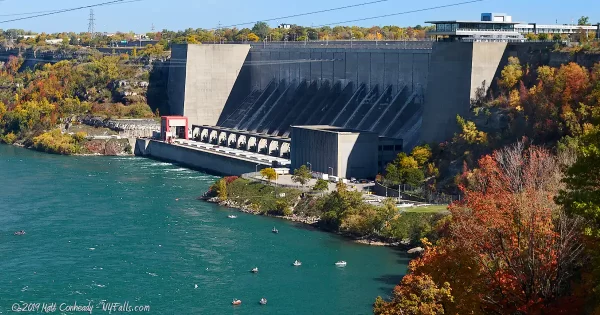
How do the power plants turn water into electricity?
How does Niagara Falls Generate Electricity?
Hydroelectric power plants are usually built around waterfalls because they take advantage of the drop in water, more precisely: the power of gravity, to use the force of falling water to generate electricity. While waterfalls can be tapped directly, and many have been, by installing a water wheel directly into the falling water, it’s typically risky as the water flow can vary and logs and other debris can hit the wheel. So typically, water is diverted from the stream of river, often stored in pools for when water flow is low, and then run through a turbine a distance away from the waterfall.
Niagara Falls is surrounded by dams and pumps that divert water from the river upstream from the falls to reservoirs and other dams downstream (but still on top of the Niagara Escarpment, so they are at a high elevation compared to the river below the falls). Those dams drop their stored water through the turbines and back into the river below. While water is what stores the energy and drives the turbines, the gravity of the water falling the distance down the Niagara escarpment is the real hero.
Here’s a more detailed breakdown of how dams and turbines turn the Niagara River’s flow and change in elevation into electricity.
- A dam built across the river diverts water into a reservoir, forming a large body of water at a higher elevation than the downstream river. In the case of Niagara Falls, The International Control Dam and a system of pumps upstream divert the river through large underground tunnels downstream to the Sir Adam Beck and Robert Moses Niagara Reservoirs north of Devil’s Hole. Both Reservoirs sit on the cliffs above the river.
- Between the reservoirs and the Niagara River are two power plants, the Sir Adam Beck in Ontario, and the Robert Moses plant in New York. They serve as both generators containing turbines and dams to hold back the reservoirs. Water is diverted from the reservoir through intake structures or tunnels and channeled towards the power plant. The intake structures are typically equipped with gates or control mechanisms to regulate the flow of water.
- The diverted water is directed to flow through large pipes or penstocks, which lead to the turbines. The force of the water causes the turbines to rotate.
- The rotating turbines are connected to generators. As the turbines spin, they turn the generators, which are essentially large electromagnets. This rotation induces the generation of electricity through the principles of electromagnetic induction.
- The generated electricity is then sent through transformers to increase its voltage for efficient transmission over long distances. It is then transported via transmission lines to the electrical grid, where it can be distributed to homes, businesses, and other consumers. These huge networks of transformers can be seen from NY I-190 (to the west) as you pass by the reservoirs, and Ontario’s can be seen from the park containing the Floral Clock, off of Heath Lane.
How much power is generated by Niagara Falls?
The amount of electricity the power plants at Niagara Falls have the capacity to output is close to 4.9 million kilowatts. That’s enough to power 3.8 millions homes.
On the US side, plants have a capacity of roughly 2.7 million Kilowatts, while the Canadian side’s combined capacity is close to 2.2 million kilowatts.
This number does not include the two Decew Falls stations in St. Catherines, ON that have a total capacity of roughly 167,000 kilowatts generated from the Welland River’s drop over the Niagara escarpment.
The numbers above represent capacity, not actual power generation. The power generated by the plants on the Niagara varies on a daily, monthly and yearly basis. Factors that affect actual power generation can be anything from demand, to river flow, to tourism season.
How has power generation changed the Falls?
Most of the water that would flow naturally over Niagara Falls is diverted for power generation. Not only does this reduction tame the appearance of the cataract, but it also curbs the erosive action and thus recession speed of the Falls, which has slowed to a relative crawl since the power plants were constructed.
The diversion of the Niagara River is acceptable to most tourists. Having never seen the Falls at full flow, most people just accept them the way they are – perhaps not even giving it a second thought. Some (including the author) think that a moderate flow gives the Falls character. It defines the edges, increases the definition of the drop, and reveals more of the gorge below (including the rock piles below the American Falls).
Others feel that the Falls in the diverted state is just “unnatural” and that they could be larger, louder, and more powerful if reverted back to their original state. Although this is an interesting concept, realizing it would not only eliminate the region’s largest supply of power, but also put the current infrastructure around the Falls and the Falls themselves in jeopardy of destruction by swift erosion. Those are giant roadblocks for returning the Falls to its original grandeur, but perhaps it wouldn’t be unthinkable to crank up the spigot a few hours or days a year to give tourists another reason to visit the Falls.
What are those structures upstream from the falls (in New York Along the Niagara Scenic Parkway and Ontario along the Niagara River Parkway)?
Two tall, windowless, rectangular structures can be found at a small park along the Niagara River upstream from the falls just west of the North Grand Island Bridge. Those traveling from New York will drive past them on the Niagara Scenic Parkway.
These ominous structures look like they are out of a sci-fi series, but they are actually very practical. They are located in the Upper Niagara Intake Observation Area, a small park built on top of the intake for water leading to the Robert Moses Power Plant Downstream. These two buildings house gates that can be raised and lowered to control the intake of water into the power project.
A pair of similar structures can be found on the Canadian side along the Niagara River Parkway and are more open to reveal the massive gate (or sluice) that is lowered to block the intake pipe underground.
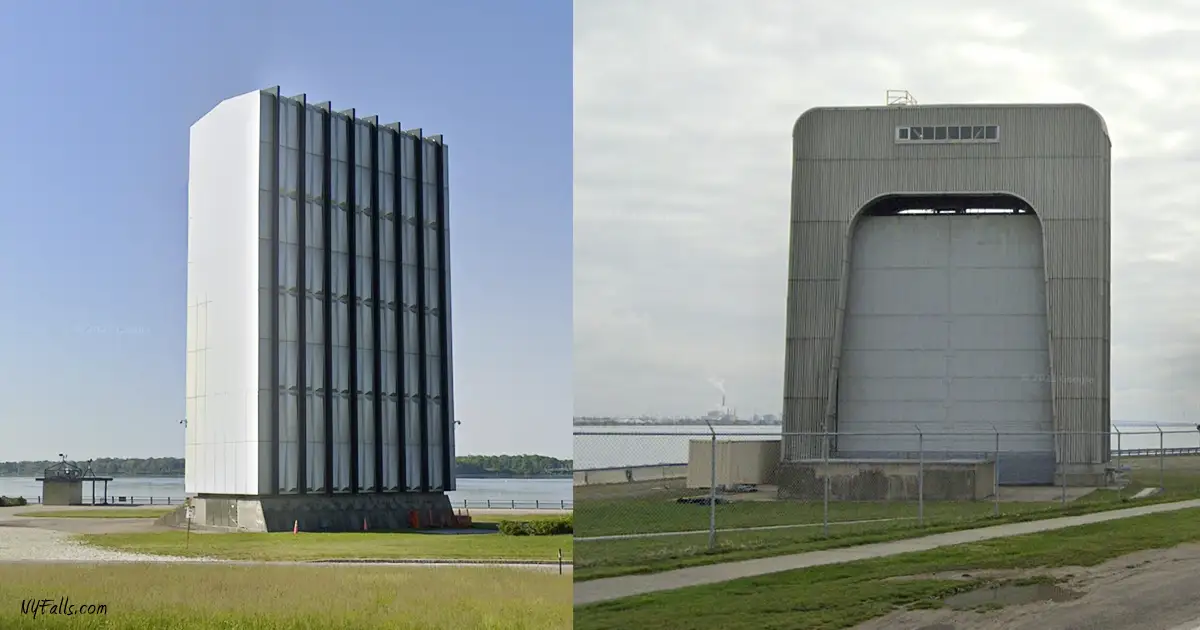
What does the International Control Dam do?
Also known as the International Control Structure, this dam is located upstream from the Canadian (Horseshoe Falls) and can be seen from walkways along the falls and rivers on both sides. It is a dam full of gates and stretches only halfway across the river, spanning the Canadian side. Built in 1954 and operated by Ontario Power Generation, it is used to control the amount of water diverted to both the US and Canadian power plants, and as a result also controls how much water is left to flow over the falls.
The 1950 Niagara Treaty not only determined how much water is allocated to power generation on either side, it also put limits on how much can be diverted, as to not interrupt the “unbroken curtain of water” flowing over the falls for tourist enjoyment.
On some occasions the dam has been used to divert an excess amount of water away from the falls to ground and stop an out-of-control vessel, suicide or daredevil attempt and to aid in rescue.
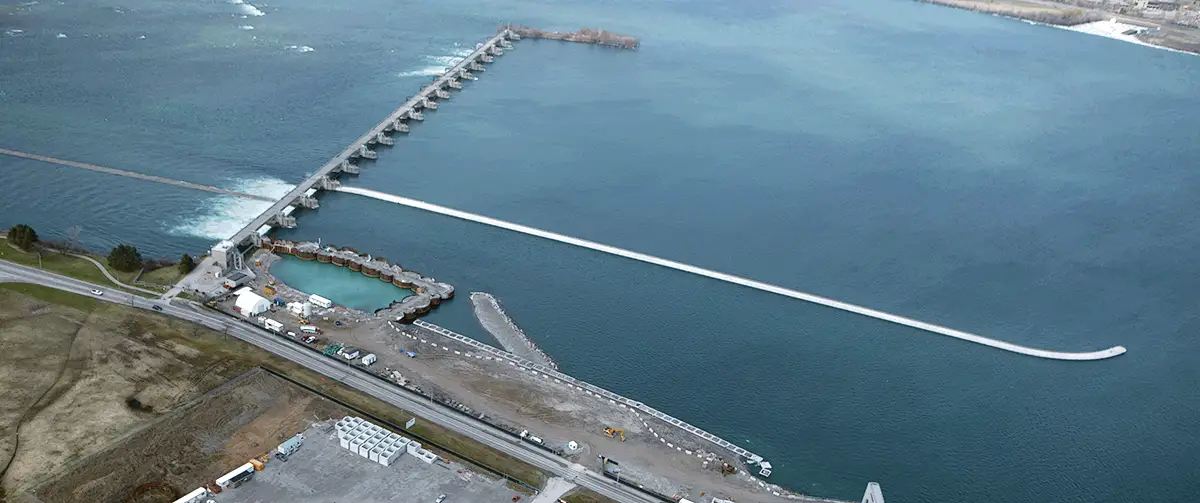
Photo credit Joe Fielder. CC BY 3.0
Niagara Falls Visitors Guide
Filled with facts and figures, tips, photos, and profiles of parks and main attractions, our guide to Niagara Falls shows you all the amazing stuff the region has to offer, while leaving out the gaudy tourist traps.




